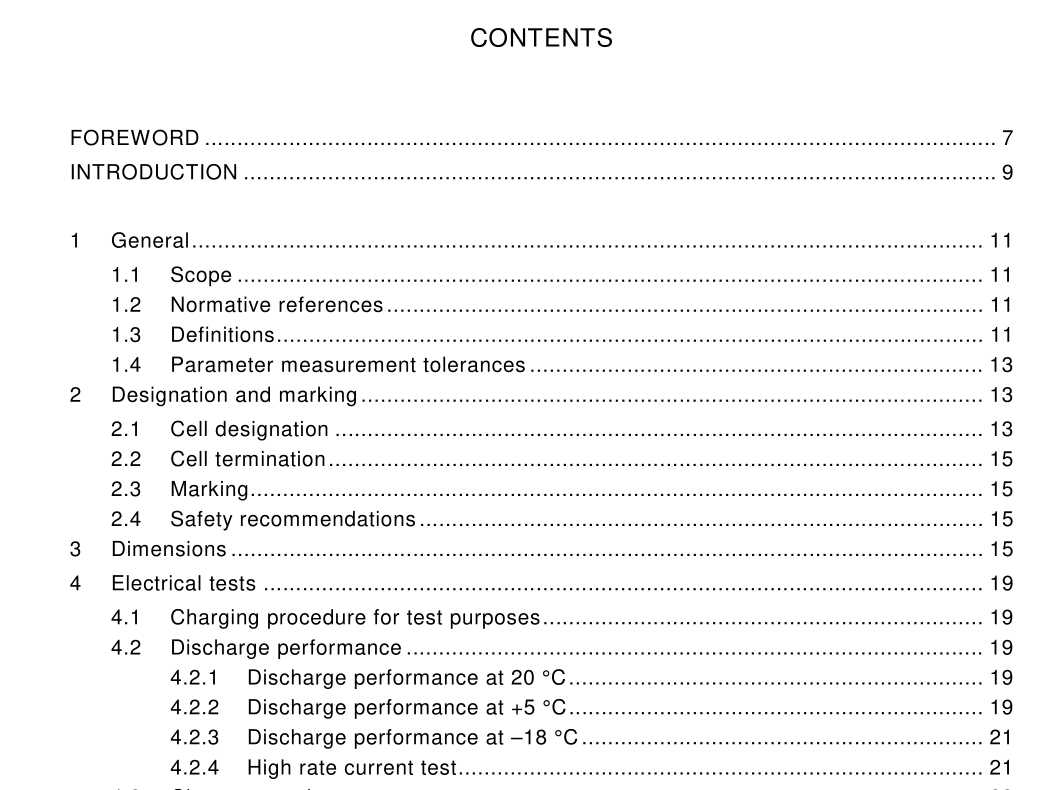IEC 60623 pdf download

IEC 60623 pdf download.Secondary cells and batteries containing alkaline or other non-acid electrolytes
1 General
1 .1 Scope
This International Standard specifies marking, designation, dimensions, tests and requirements for vented nickel-cadmium prismatic secondary single cells. NOTE In this context, “prismatic” refers to cells having rectangular sides and base. When there exists an IEC standard specifying test conditions and requirements for cells used in special applications and which is in conflict with this standard, the former shall take precedence.
1 .2 Normative references
The following normative documents contain provisions which, through reference in this text, constitute provisions of this International Standard. For dated references, subsequent amendments to, or revisions of, any of these publications do not apply. However, parties to agreements based on this International Standard are encouraged to investigate the possibility of applying the most recent editions of the normative documents indicated below. For undated references, the latest edition of the normative document referred to applies. Members of IEC and ISO maintain registers of currently valid International Standards. IEC 60050(486), International Electrotechnical Vocabulary – Chapter 486: Secondary cells and batteries IEC 60051 (all parts), Direct acting indicating analogue electrical measuring instruments and their accessories IEC 6041 0, Sampling plans and procedures for inspection by attributes IEC 6041 7 (all parts), Graphical symbols for use on equipment IEC 60485, Digital electronic d.c. voltmeters and d.c. electronic analogue-to-digital converters IEC 61 438, Possible safety and health hazards in the use of alkaline secondary cells and batteries – Guide to equipment manufacturers and users
1 .3 Definitions
For the purpose of this International Standard, the definitions contained in IEC 60050(486) and the following apply.1 .3.1 vented cell a secondary cell having a cover provided with an opening through which gaseous products may escape. NOTE The opening may be fitted with a venting system. 1 .3.2 nominal voltage the nominal voltage of a vented nickel-cadmium rechargeable single cell is 1 ,2 V 1 .3.3 rated capacity quantity of electricity C 5 Ah (ampere-hours) declared by the manufacturer which a single cell can deliver when discharged at the reference test current of 0,2 I t A to a final voltage of 1 ,0 V at +20 °C after charging, storing and discharging under the conditions specified in clause 4
NOTE 1 The dimensions given in tables 1 a and 1 b represent preferred values. NOTE 2 The widths relate to the overall width dimension of the cell excluding the thickness of the lug flanges. The values for widths and lengths given in tables 1 a and 1 b are maximum values; their negative tolerances are given in table 2. NOTE 3 The values for height given in tables 1 a and 1 b relate to the maximum height over the terminals or the closed cell vent, whichever is the greater. No lower limits are stated. NOTE 4 The dimensions shown in tables 1 a and 1 b are not associated to particular cell capacities. They apply to all kinds of vented nickel-cadmium prismatic cells, i.e. L, M, H and X types.
4 Electrical tests
Charge and discharge currents for the tests in accordance with 4.1 to 4.9 inclusive shall be based on the value of the rated capacity. 4.1 Charging procedure for test purposes Prior to charging, the cells shall have been discharged at 20 °C ± 5 °C, at a constant current of 0,2 I t A, down to a final voltage of 1 ,0 V. Unless otherwise specified in this standard, the charge preceding the various discharge tests scheduled, shall be carried out in an ambient temperature of 20 °C ± 5 °C and at a constant current of 0,2 I t A. The duration of the charge shall be 7 h to 8 h. 4.2 Discharge performance The following discharge tests shall be carried out in the sequence given. All cells shall be tested at 20 °C as well as at +5 °C and/or –1 8 °C. 4.2.1 Discharge performance at 20 °C The cell shall have been charged in accordance with 4.1 . After charging, the cell shall be stored for not less than 1 h and not more than 4 h in an ambient temperature of 20 °C ± 5 °C. It shall then be discharged in the same ambient temperature and as specified in table 3. The duration of discharge shall be not less than the minimum specified in table 3.









